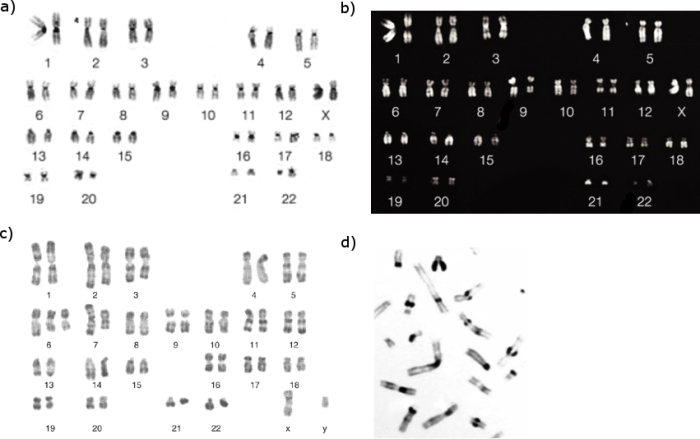Light G Bands That Appear Along Chromosomes Contain ...
Using this abnormalities of chromosomes can be determined. The dark bands contain mainly A-Trich DNA and the light bands are G-C rich.
3 R-banding - gives the reverse of G-banding dark G-bands appear light light G-bands appear dark.

. Chromosomal Banding A chromosome banding pattern is comprised of alternating light and dark stripes or bands that appear along its length after being stained with a dye. Light G bands that appear along chromosomes contain. Because G-dark bands contain fewer genes and are less GC-rich than G-light bands Craig and Bickmore 1993 it is not surprising to observe a significant correlation between chromosome gene number GC content and centromere localization Figure 3c.
Light G bands that appear along chromosomes contain. They appear as light color bands upon staining in G banding whereas heterochromatin appears darkly stained. Dark and light bands represent G and R bands respectively.
A DNA intercalating agent and a fluorescent compound the bands appear only when the chromosomes are exposed to ultraviolet UV light. A chromosome banding pattern is comprised of alternating light and dark stripes or bands that appear along its length after being stained with a dye. Heterochromatin Is the relatively more condensed region of chromosomes 18.
Manipulation of the cell cycle to produce prometaphase chromosomes with resolution of 550 G-bands per haploid set provides a mechanism for high-resolution. Euchromatin Is the relatively less condensed region of chromosomes 17. A Dark G bands that appear along chromosomes contain O heterochromatic regions.
A unique banding pattern is used to identify each chromosome and to diagnose chromosomal aberrations including chromosome breakage loss duplication or inverted segments. Chromosome 1 contains a large block of heterochromatin close to the centromere grey. C-bands centromeric bands and NORs nucleolus organizer regions.
The staining of chromosome is known as banding technique because stains give rise to pattern of bands along the length of chromosome. Chromosomes Chromosomes are microscopic units containing organized genetic information located in the nuclei of diploid and haploid cells eg human somatic and sex. If the haploid number for a plant species is 4 how many chromosomes are found in a member of the species that has one of the following characteristics.
Housekeeping genes which are early replicating and actively transcribed in almost all cells reside on G-light bands also called R bands. On using this stain dark and light bands appear. One light band and one intermediate band.
Lightly stained is Euchromatin which is GC rich. Submit Request Answer Part G Use components to find the magnitude of B-A. The bands appear only when the chromosomes are exposed to ultraviolet UV light.
G bands Are darkly stained regions of compacted chromosomes heterochromatin that have been stained with Giemsa 16. Of the molecules generated in the third round 75 are completely light 25 are intermediate. During interphase the vast majority of late replicating bands from most if not all chromosomes are localized at the nuclear periphery with a smaller fraction present around the nucleolus or scattered in the nucleoplasm.
The band pattern is different for different chromosome. 2 Q-banding - a fluorescent stain that gives the same banding pattern as G-banding. If you want to make a water-soluble salt using the zincll cation Zn2 what anion would you choose.
G-Q and R-bands these bands are distributed along the length of the whole chromosome. Mammalian chromosomes are comprised of complex chromatin architecture with the specific assembly and configuration of each chromosome influencing gene expression and function in yet undefined ways by varying degrees of heterochromatinization that result in Giemsa G negative euchromatic light bands and G-positive heterochromatic dark bands. 1 G-banding - currently the most widely used method.
Part B Light G bands that appear along chromosomes contain. The tightly packed DNA is heterochromatin AT rich takes more dye and stains dark. B The banding pattern is characteristic for each chromosome pair.
A Ideograms of chromosome 1 at the 550-band and the 850-band level. Submit Previous Answers Request Answer X Incorrect. However none of these variables alone adds any significant explanatory power to the above.
O A NO3 O B CO32-. Ultraviolet light causes the quinacrine molecules to shine therefore parts of the chromosome intercalated with quinacrine shine brightly whereas other parts remain dark. Part B Light G bands that appear along chromosomes contain.
Telomere is located at the end of chromosome that contains repetitive nucleotide sequences and centromere is located at the center of chromosome which links the sister chromatids thus they are not applicable. Dark G bands that appear along chromosomes contain. Submit Previous Answers Request Answer Incorrect.
This representation is used for comparison to height profiles along chromosomes. R-banding is a useful complement to G-banding because some small light G band can be more easily detected when they are. Hence the dark G band that appears in G banding is heterochromatin.
They are used to stain a restriction number of specific bands or structures. Light G bands that appear along chromosomes contain. C-banding methods do not permit identification of every chromosome in the somatic cell complement but can be used to identify specific.

G Banding An Overview Sciencedirect Topics

Chromosome Banding An Overview Sciencedirect Topics

Chromosome Banding Pattern An Overview Sciencedirect Topics

C Banding An Overview Sciencedirect Topics

Chromosome Banding An Overview Sciencedirect Topics

Cardiolipin Deficient Cells Have Decreased Levels Of The Iron Sulfur Biogenesis Protein Frataxin Journal Of Biological Chemistry

Chromosome Banding An Overview Sciencedirect Topics

G Banding An Overview Sciencedirect Topics

G Banding An Overview Sciencedirect Topics

The Elements Of Genetics Irwin H Herswkowitz Genetics Chromosome Element

Chromosome Identification An Overview Sciencedirect Topics

Centromere An Overview Sciencedirect Topics

Chromosome Analysis For Infertility And Miscarriage

Karyotyping Learn Science At Scitable

Chromosome Banding And Mechanism Of Chromosome Aberrations Intechopen




Comments
Post a Comment